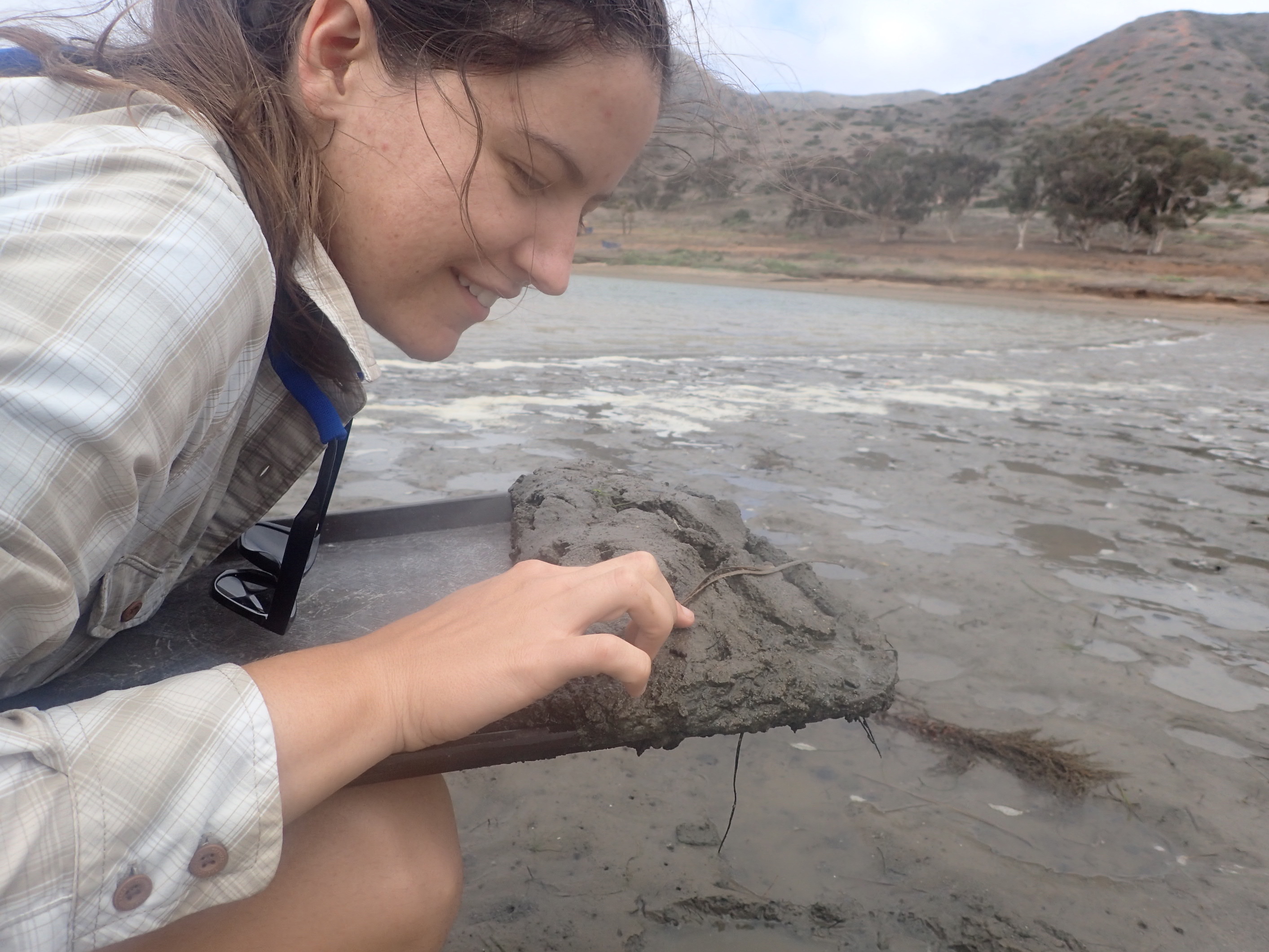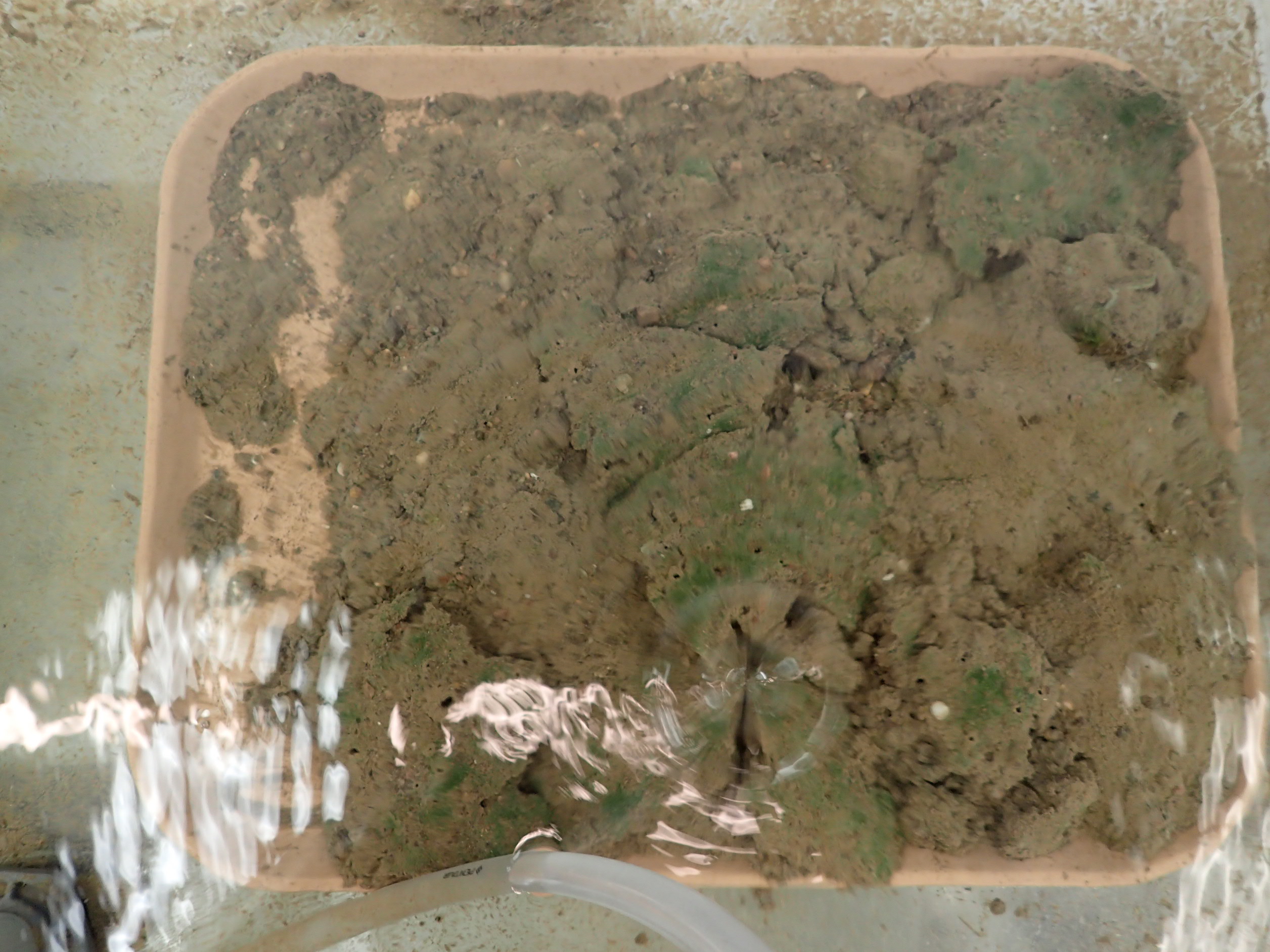By: Claire Johnson
A recent collecting trip in early July, the morning after the big July 6th fireworks blowout, took me into the bustling (truly!) town of Two Harbors from the Wrigley Institute. This is about a 2 mile journey, and in 90 degree morning heat with lunch trays full of dense, fine grained, water-saturated mud, walking was not an option.
The morning started with a mix up of who’s electric vehicle was who’s—after some panic on my part, Ann Close agreed to drop me off in a 10-passenger van in time for low tide around 10:45am. The drive is quite scenic: up from the Wrigley base camp, to a road dug into the red mountain side with panoramic views of several quaint deep blue harbors filled with ant-sized white boats. I’ll never get tired of it.
I take this road 1-2 times per week to collect cyanobacterial mats and tiny snails and crabs from Cat Harbor mud flats for my research as a Wrigley Fellow. These I bring to the Wrigley lab and observe, using several methods in a controlled experimental setting, how animal activities alter the surface of the seafloor. I designed these experiments to be similar to points in the very ancient past, or ‘deep time.’
The stretch of deep time I study begins about 252 MILLION years ago and continues for about 40 million years after that, also called the Triassic period (just before the famed Jurassic, of Jurassic Park!). Much of the Triassic is abundant in marine seafloor microbes, like cyanobacteria, that aid in the building of rocks that are preserved even today. These microbes also had a lot of animals crawling around on them. This is cool, and how animals lived can tell us a lot about what the living conditions in the past were like. But, and it’s a big but, all these things are dead now, effectively frozen in time. They can’t talk to us. The next best thing we have are modern (living) analogs that we can actively monitor—and the cyanobacterial mud flats on Catalina are some of our best bets.
I’ve made this trip to collect the mud several times now, but this a particular day was full of delicate-looking people fending off the heat and perhaps too much fun the night before. Pedestrians strolled down roadways, squinting in the sun, while motorists seemed just as dazed. A person in a SUV backed their car into a pole. It seemed the heat was getting the better of most of us.
The ‘heat’ in the metaphorical sense, had been getting the better of me too. I had not had much luck keeping my collected cyanobacteria alive in the lab for more than a few days. This has been incredibly demoralizing. When you’re a scientist who can’t get their science to science, you know how it feels! Replace your profession where ‘science’ is and you’ll also get it. I had expected them to flourish for at least a week at a time to get my experiments running smoothly, and this was just not happening.
So on this particular morning, things were not looking so good on my end as Ann and I took the van into town. The road out to the mud flat was loaded with people and one gunky looking dog walking a little sideways in front of our car. Poor buddy looked like he had fallen in a cactus patch, which as we came to know, was exactly what happened to him. His rescuers didn’t know who he was. Ann took the reins of the situation and dropped me on the shore for low tide.
Low tide is the time to collect cyanobacteria with the mud flat at its flattest and muddiest—the technical term in geology lingo is ‘sub-aerially exposed.’ This particular tide was a little high for low tide, and some of the cyanobacterial mats were submerged—spotting them was tricky. I hit the gold (green?) mine when I found a section of underwater mud with pearly bubbles and a faint green tinge. Big bubbles are a dead giveaway for photosynthesizing underwater microbes. Living for these guys involves harvesting sunlight, soaking it up, simultaneously ‘breathing’ in carbon dioxide (that infamous greenhouse gas), then expelling gaseous oxygen, which is trapped as bubbles on the surface of the mat, sticky and filamentous as it is. The garbage of the microbes is the lifeblood for us animals, providing livable habitat for millions of years. We are so intimately connected by oxygen!
I was able to collect several spatulas worth of the mats to deposit on my two lunch trays, just as Ann rolled up with the van. While I was mucking about, Ann was being a true hero. She found the dog from earlier, stumbling around from the cactus and heat, and brought him to his worried sick dog parents. He had fallen off their boat during the fireworks, scared and disoriented, swam to shore and got stuck in the cactus. All at the age of 16. Poor guy!
Fortunately, this is the most eventful a sampling trip ever got. Unfortunately, those mats I collected on that trip got orange, shriveled up and died a few days later. This is real life science, people. Not a happy ending yet, but we’re getting there! Thoughts of optimism are encouraged, thanks!




